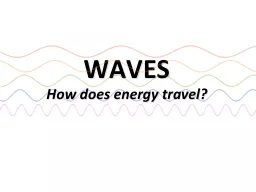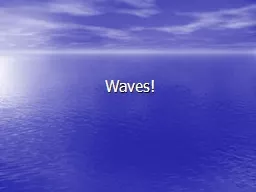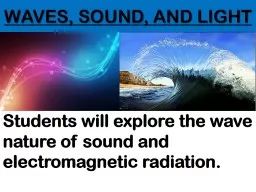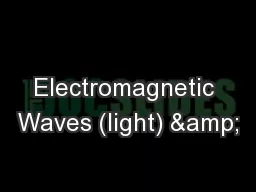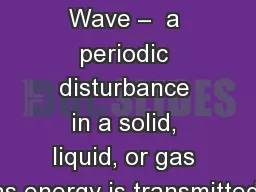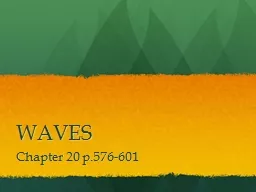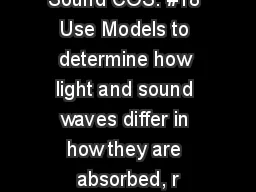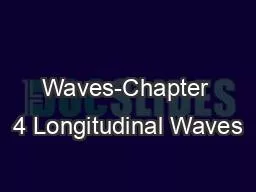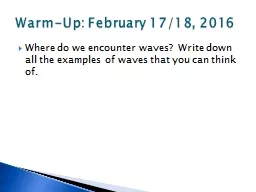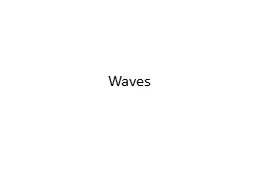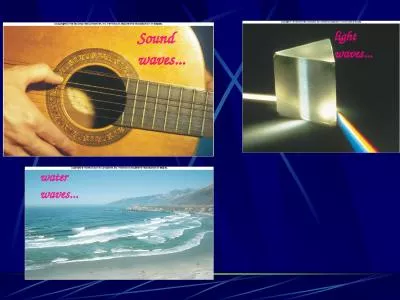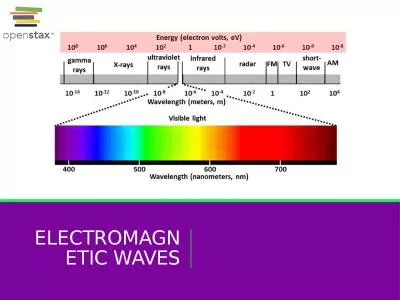PPT-WAVES How does energy travel?
Author : jane-oiler | Published Date : 2018-02-25
Waves Waves rhythmic disturbances vibrations that transfer energy through matter or space carry energy from one place to another Very disturbing Waves Water
Presentation Embed Code
Download Presentation
Download Presentation The PPT/PDF document "WAVES How does energy travel?" is the property of its rightful owner. Permission is granted to download and print the materials on this website for personal, non-commercial use only, and to display it on your personal computer provided you do not modify the materials and that you retain all copyright notices contained in the materials. By downloading content from our website, you accept the terms of this agreement.
WAVES How does energy travel?: Transcript
Waves Waves rhythmic disturbances vibrations that transfer energy through matter or space carry energy from one place to another Very disturbing Waves Water Waves How does the video display what a wave is. 8. th. Grade Physical Science . Question: . What type of wave is a sound wave? . Waves. 3/10/15. Wave. —a repeating movement or disturbance that transfers energy through matter or space. . All waves carry energy without transporting matter from place to place. . First a little . vocab. …. WAVE: . A periodic disturbance in a solid, liquid or gas. Some waves (light) can travel through empty space. MEDIUM:. Matter or space through which waves travel. I. Waves transfer energy. Students . will explore the wave nature of sound and electromagnetic radiation. . Identify . the characteristics of electromagnetic and . mechanical waves. . . b. Describe how the behavior of light waves . Comparing Wave Properties & Energy. Essential Standard. 6.P.1Understand the properties of waves and the wavelike property of energy in earthquakes, light and sound waves.. Clarifying Objective. 6.P .. the Electromagnetic Spectrum. Waves. All waves carry … ENERGY!!!. Electromagnetic Waves (light) . Light waves are . transverse. waves. Electromagnetic. Radiation. Energy emitted from the . Seismic . Waves. . are shock . waves . given off by earthquakes. . There are 2 types:. 1. . Body Waves. . originate from the . focus. (. F. ). travel . through. . the earth. . They’re used to locate . Waves transfer energy!. A wave does not carry matter . It only moves matter as it travels through it.. Waves. Compression (longitudinal) waves . are waves in which the particles of the medium move in a direction . Section 1. Objectives. 1. Explain the relationship among waves, energy, and matter. 2. Describe the difference between transverse waves and compressional waves. A. Waves Carry Energy. Waves (rhythmic disturbances that carry energy without carrying matter) can carry energy by itself or with matter. Producing and Detecting sound. What is sound?. The sound you hear is sound waves that can only travel through matter.. Sound waves are longitudinal waves. . Sources of sound. Every sound comes from a vibration, which is the energy that the wave uses to carry the sound.. Before the waves are made the particles are same distance apart. While waves moves through the medium the particles . compress. together, then they spread further apart (stretched areas)- . rarefaction.. Warm-Up: February 17/18, 2016. Vibrations and Waves. Chapter 14. A . periodic motion . repeats in a regular cycle.. Examples include:. Pendulums (such as on a grandfather clock). A mass at the end of a spring. carries energy . through matter or space. . Water . waves, sound waves, and . the waves . that travel down a rope or spring are types of mechanical . waves. Mechanical . waves require a medium. .. A . water. waves.... 4/5/2019. Physics 214 Fall 2010. 2. 1S-13 Slinky on Stand. Creating longitudinal compression waves in a slinky. What happens when you pull back and release one end of the slinky . ? . The Scottish physicist James Clerk Maxwell (1831–1879) was the first person to truly understand the fundamental nature of light. . He proved in 1865 that an electromagnetic disturbance should propagate in free space with a speed equal to that of light..
Download Document
Here is the link to download the presentation.
"WAVES How does energy travel?"The content belongs to its owner. You may download and print it for personal use, without modification, and keep all copyright notices. By downloading, you agree to these terms.
Related Documents

